I planted white Canterbury bells (Campanula medium ‘Alba’) in the cut-flower garden one sunny day last week, a task that did my heart good. Almost 100 sturdy baby plants, all raised from a single packet of seed sown in June, with the baby seedlings pricked out into a cell tray to grow them on and fatten them up over summer. A cottage garden favourite native to France and Italy, with tall, sturdy stems covered with clusters of large, bell-shaped flowers that can be deep blue, pink or snow white depending on the variety, this hardy, resilient biennial has a centuries-long history of cultivation.
Records of its common name stretch from medieval times, supposedly a reference to the flowers’ similarity in shape to the small bells that pilgrims to Canterbury carried on their horses. In the US, where it was one of the first imported species of flowers to be cultivated in colonial America, the former American president and passionate gardener Thomas Jefferson grew Canterbury bells in profusion in his garden at Monticello in Virginia. The famous English designer and garden writer Gertrude Jekyll grew them too, studiously avoiding the flashy double-flowered varieties, which she described as “confused and disfigured”, in favour of the timeless beauty of the simpler single-flowered types.
This hardy early-summer-flowering plant is one of a handful of biennials that I wouldn’t be without. Another is Sweet William, or Dianthus barbatus, a sweetly scented, supremely easy-to-grow biennial and magnificent cut flower that has similarly withstood the changing tides of horticultural fashion. It is hardy, long-flowering, extraordinarily resilient and tolerant of a wide range of growing conditions so long as it gets plenty of sun, and it forms a dense, semi-evergreen, low carpet of foliage from which its tight clusters of colourful, edible, pollinator-friendly, perfumed flowers emerge in late May-June. Trays of young plants are often available in garden centres at this time of year and if planted out this month, will bloom early next summer. Many named varieties are available with flowers in shades of pink, red, white and plum, some of them bi-coloured, all easily raised from seed. As is true of Canterbury bells, Sweet William also readily self-seeds when it’s happy, producing seedlings that can be easily moved to their final growing position over the coming weeks. Large quantities of ripe seed can also easily be hand-collected at this time of year from mature plants.
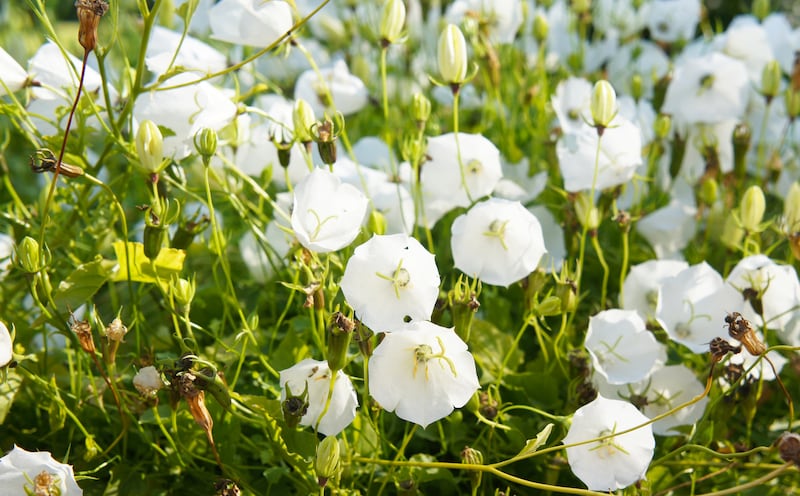
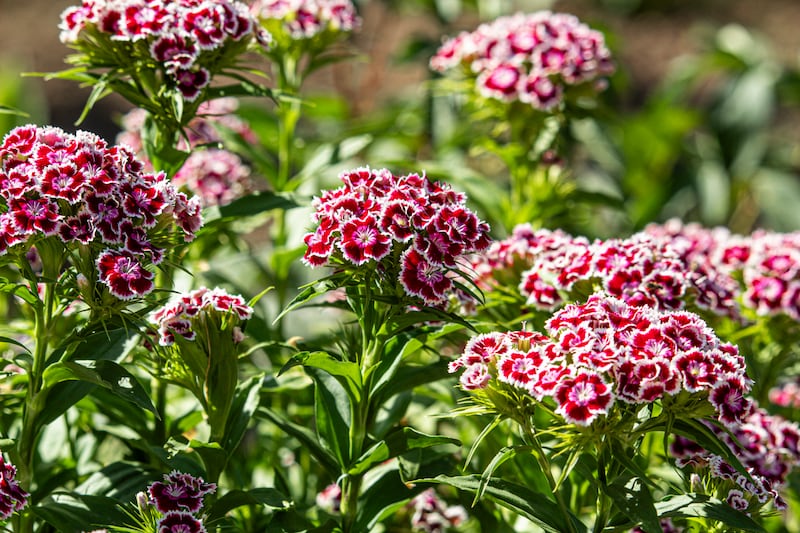
Another biennial on my must-grow list is the foxglove, or ‘fairy thimbles’ as it’s traditionally known. Not the wild species, Digitalis purpurea, with its tall, graceful spires of dark pink-purple flowers, but both the white-flowered Digitalis ‘Alba’ and Digitalis ‘Sutton’s Apricot’. Just as for Canterbury bells and Sweet William, I sow seed of this cottage garden favourite in late spring/early summer and prick the seedlings out into a cell tray before planting them into their final positions at this time of year, watering them in very well. Young plants slowly form strong basal rosettes of foliage from which their stately blooms gracefully emerge the following year as summer arrives.
READ MORE
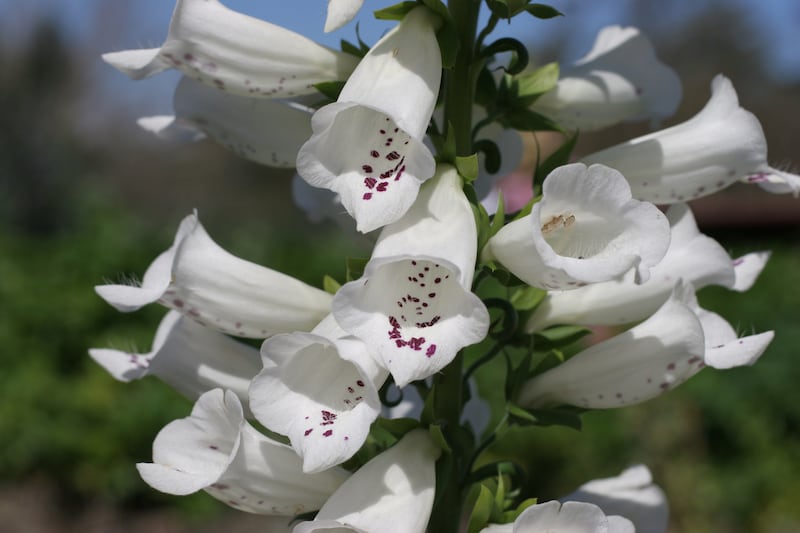
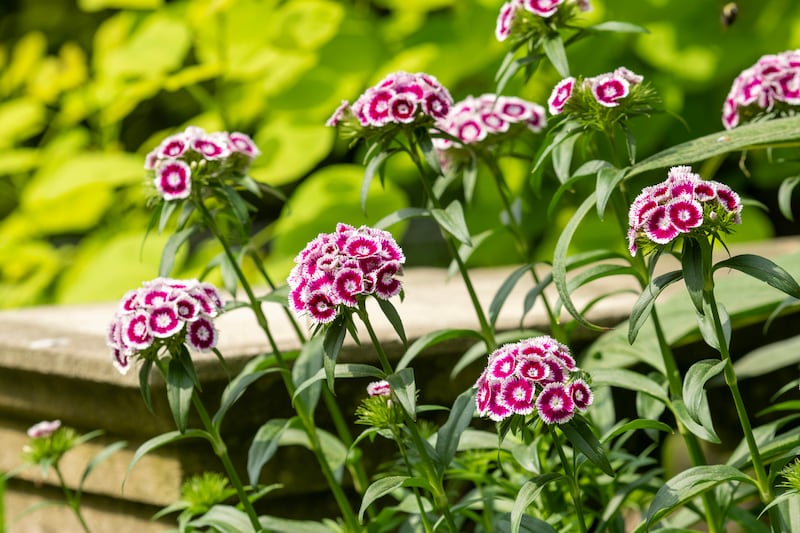
Left to self-seed, foxgloves often do so in great abundance, although some of the resulting seedlings are very likely to revert to the wild species, meaning they’re best sown from purchased seed if you want to preserve the more pastel shades. They are happy in light shade or full sun and a damp, humus-rich but free-draining soil. Germination is triggered by exposure to light, which is why they can so often be seen flowering in profusion on sites where woodlands have been recently felled. Some gardeners avoid growing them on the basis that they’re poisonous. But if we were to apply this rule to every species, our gardens would be the poorer.
Early autumn is also the time to plant wallflowers (Erysimum cheiri), yet another hardy biennial species and a cottage garden favourite with a centuries-old history of cultivation. As a student at the National Botanic Gardens in Glasnevin sent out on work placement to various parks around Dublin, I helped to fill the city’s public flowerbeds with these traditional spring bedding plants in jaunty shades of acid yellow, bright orange and blood-red. The young plants were delivered bare-rooted in tight bundles wrapped in damp newspaper, the same way that they can be found in some garden centres at this time of year for sale. Although their popularity has faded somewhat, I’ve noticed the beginnings of a revival, perhaps partially fuelled by nostalgia for a simpler age but also by the availability of a new range of varieties with flowers in more subtle, muted shades or with double blooms such as the new, exceptionally long-flowering Taffeta series.
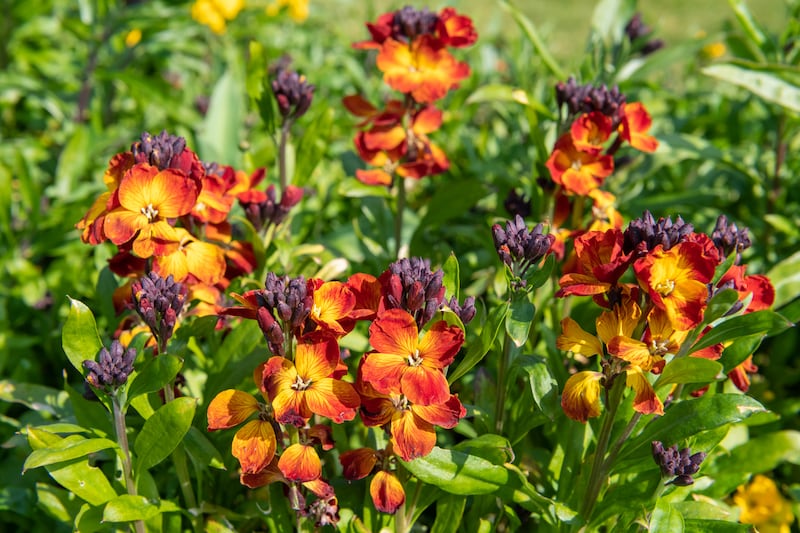
Wallflowers, colourful and famously deeply scented, are traditionally used as a lovely accompaniment to spring-flowering bulbs. They also make excellent cut flowers. Just bear in mind that the plant’s common name is an indication of its strong preference for a very free-draining, stony soil in full sun where it will self-seed when it’s happy. It is sometimes known as ‘wall gilliflower’; the story goes that its seeds first arrived in England with limestone that William the Conqueror brought from Normandy in the 11th century to build his castles. In Ireland wallflowers or ‘lus an bhalla’ can often be seen growing in the walls of old ruins where the species has become naturalised.
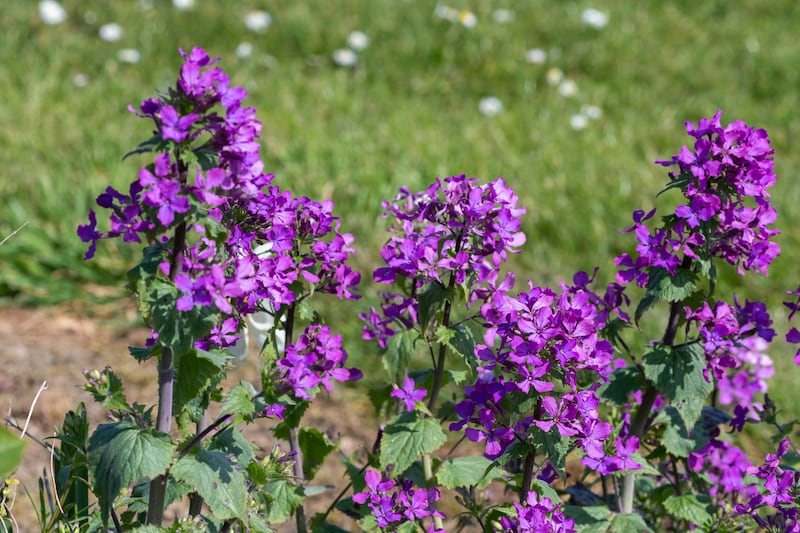
Flowering at the same time of year, the hardy biennial known as honesty or Lunaria annua is equally invaluable as a companion plant for spring-flowering bulbs such as tulips, narcissus, allium and fritillaria, its tall, frothy flower stems providing the perfect soft foil to these bulbous species’ more architectural blooms. It is best grown in full sun or light shade in a cool, moist but free-draining soil, and it also liberally self-seeds when it’s happy. If you already grow it, now is a good time to start searching for its baby seedlings to pot on or move into their final positions in the garden as well as to home-save the ripe seed for future use. The deep purple-pink flowers of the species are very pretty as are the violet-blue flowers of Lunaria ‘Corfu Blue’ but my favourite is the white-flowered Lunaria annua ‘Alba’. All produce the highly ornamental, disc-shaped ‘silver dollar’ or ‘silver penny’ seedheads for which the species is so well known.
This week in the garden
This is a good time of year to summer prune established cordon-trained apple trees and fan-trained fruit trees as well as gooseberry bushes, currant bushes and summer-fruiting raspberries to encourage well-proportioned, productive plants and plenty of fruit-bearing branches for next year. rhs.org.uk
Late August-early September is also the best time to clip back beech, hornbeam, Thuja and Leylandii garden hedges.
Dates for your diary
Friday-Sunday, August 30th-September 1st, 2pm-6pm: Festival of Flowers, a celebration of the centenary of St Oliver Plunkett Church, Sea Road, Haggardstown, Blackrock, Co Louth, A91 WD56, curated by the Chelsea gold medal-winning garden designer Paul Martin with an outstanding array of displays by floral designers including Jenny Murphy (also a Chelsea gold medal winner), Caroline Slevin, Blooms and Strandfield, all welcome.
Saturday August 31st, 2.30pm-4.30pm: St Nessan’s Community School, Baldoyle, Dublin, D13 F6N3, Howth & Sutton Horticultural Autumn Show and Plant Sale, new exhibitors welcome. hshs.ie


















